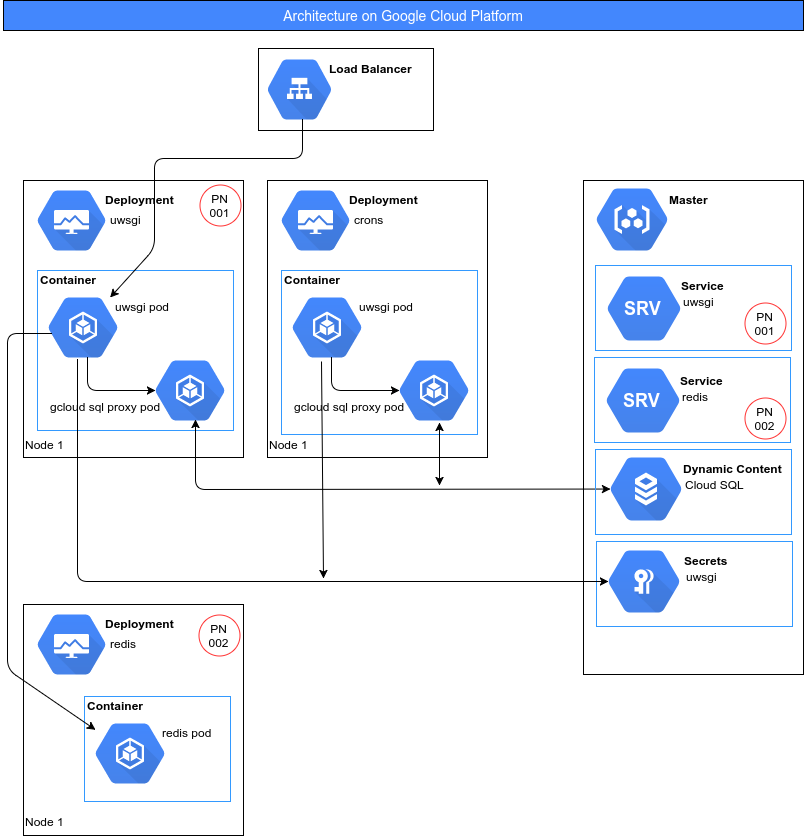Dependencies
Helm & Tiller
First of all you need to install the Helm client following the next
instructions:
curl https://raw.githubusercontent.com/kubernetes/helm/master/scripts/get > get_helm.sh
chmod 700 get_helm.sh
./get_helm.shFor deploys is also needed the server portion of Helm, Tiller (it
talks to a remote Kubernetes cluster).
To install it into the cluster, simply runs:
helm initFor more information take a look at: Install Helm
Packages
To use this repository as a k8s charts repository for deploy your apps you have to configure helm adding it:
helm repo add apsl https://raw.githubusercontent.com/APSL/kubernetes-charts/master/packages/Check that it has been added.
helm repo list
NAME URL
stable https://kubernetes-charts.storage.googleapis.com
incubator https://kubernetes-charts-incubator.storage.googleapis.com/
local http://127.0.0.1:8879/charts
apsl https://raw.githubusercontent.com/APSL/kubernetes-charts/master/packages/
Structure of repository
kubernetes-charts/
├── packages/ # Reult folder where construct temporaly packages before be installed.
| ...
| ├── index.yaml # Contains the configuration for a django app deployment.
| ├── django-nginx-uwsgi-0.1.1.tgz # Django package. It includes nginx, uwsgi, redis, varnish packages.
| ├── uwsgi-0.1.1.tgz # Uwsgi package.
| └── varnish-0.1.0.tgz # Varnish package.
...
├── django/ # Contains the configuration for a django app deployment.
| ├── .helmignore # List of patterns to ignore when build the package.
| ├── Chart.yaml # A YAML file containing information about the chart.
| ├── requirements.yaml # List of required charts and their overriden configuration.
| ├── values.yaml # The default configuration values for this chart
| ├── charts/ # Include all dependency packages
| | # IMPORTANT: No commit packages into.
| └── templates/ # A directory of templates that, when combined with values.
| └── _helpers.tpl # Difinition of template variables.
| # Note that not require templates because this chart only encapsulate
| # dependencies.
└── uwsgi/ # Contains the configuration for a uwsgi deployment.
├── charts/ # Folder that contains built packages for the dependecies of this chart.
| # IMPORTANT: No commit packages into, will be auto-generated.
├── .helmignore # List of patterns to ignore when build the package.
├── Chart.yaml # A YAML file containing information about the chart.
├── requirements.yaml # List of required charts and their overriden configuration.
├── values.yaml # The default configuration values for this chart
└── templates/ # A directory of templates that, when combined with values.
├── NOTES.txt # A plain text file containing short usage notes (rendered with Go Template engine)
├── _helpers.tpl # Definition of template variables.
├── deployment.yaml # Structure of deployment for this chart.
├── secrets.yaml # Base secrets for the chart.
└── service.yaml # Structure of service for this chart.Take a look to The Chart File Structure to get acquainted to chart structure.
The django-nginx-uwsgi chart is a generic Helm chart for deploy a
Django application with a simple architecture:
How to
This section will try to explain you how to use this repository to deploy your applications.
How to deploy a chart over Kubernetes?
Will show you the procedure to deploy a Django application using this charts.
This example we'll deploy an app called demo, suposing you satisfy all dependencies.
- Deploy the Django application.
helm install PACKAGE --version VERSION --namespace NAMESPACE --name RELEASE_NAME -f VALUES- PACKAGE → The path to stored package.
- VERSION → The exact version of the package to install. If it is not set the last version will be deployed.
- --namespace NAMESPACE → The namespace that will be create on Google Cloud Platform and will be user with in the deployment.
- --name RELEASE_NAME → It must has a different value to namespace. It is used in the deployment and dependencies deployments.
- -f VALUES → Path to the file where are all values that
overrides the Helm chart, for example
SECRET_KEYorDATABASE_PASSWORD, etc.
helm install apsl/django-nginx-uwsgi --version 0.1.1 --namespace demo --name r-demo -f your_demo_app_values.yamlHow to test your deployment before apply it on your K8s cluster?
Helm Template is a plugin used to render the resultant deployment of your chart.
- Install:
helm plugin install https://github.com/technosophos/helm-template- Use it:
helm template -n NAMESPACE -r RELEASE_NAME -f VALUES --notes CHART > output.yaml- -n NAMESPACE → The namespace used with in deployment.
- -r RELEASE_NAME → The release name used with in deployment.
- -f VALUES → Override specific values for application.
- --notes → Render the NOTES.txt file chart's dependencies notes.
- CHART → Location path to the chart.
helm template -n demo -r r-demo -f your_demo_app_values.yaml --notes . > ~/k8s-deployment.yamlContributors
Developing new Helm charts
There are some notes and some command line instructions that can be useful as a guide how to develop new charts.
To create a new chart:
helm create CHART- CART → Full path to destination chart.
helm create django-nginx-uwsgiAfter develop your template chart, you can validate if your chart is valid running a lint.
helm lint django-nginx-uwsgiBuilding package
If you contribute creating niw Charts or improving the existent you should do this:
- Serve your packages locally
- Update dependent locally repositories your Chart
- Generate your package
- Regenerate index-yaml
To simplify all this tasks, you only have to execute this:
make helm-up & \
make helm-packages && \
helm repo index packagesNOTE: Its possible see some non-liveness message using make command to build packages. If the message is like "No requirements found in ~/kubernetes-charts/nginx-uwsgi/charts" ignore it. It is because the commnand script try to get dependencies of all packages even if it has not charts (the dependency folder).
Use case:
We will generate a new chart packagedemo_:
- Create the chart
helm create packagedemo- Serve built local packages:
cd packages
helm serve- Build all dependent packages:
helm package -u -d packages uwsgi
helm package -u -d packages nginx
helm package -u -d packages packagedemoor use the Makefile commands:
make helm-packages- Generate index
helm repo index packagesor use the Makefile commands:
make helm-index- Test to show resultant yaml for deployment:
helm template packages/packagedemo-0.0.1.tgz -n demo -r r-demo -f your_demo_app_values.yaml --notes . > ~/k8s-deployment.yaml